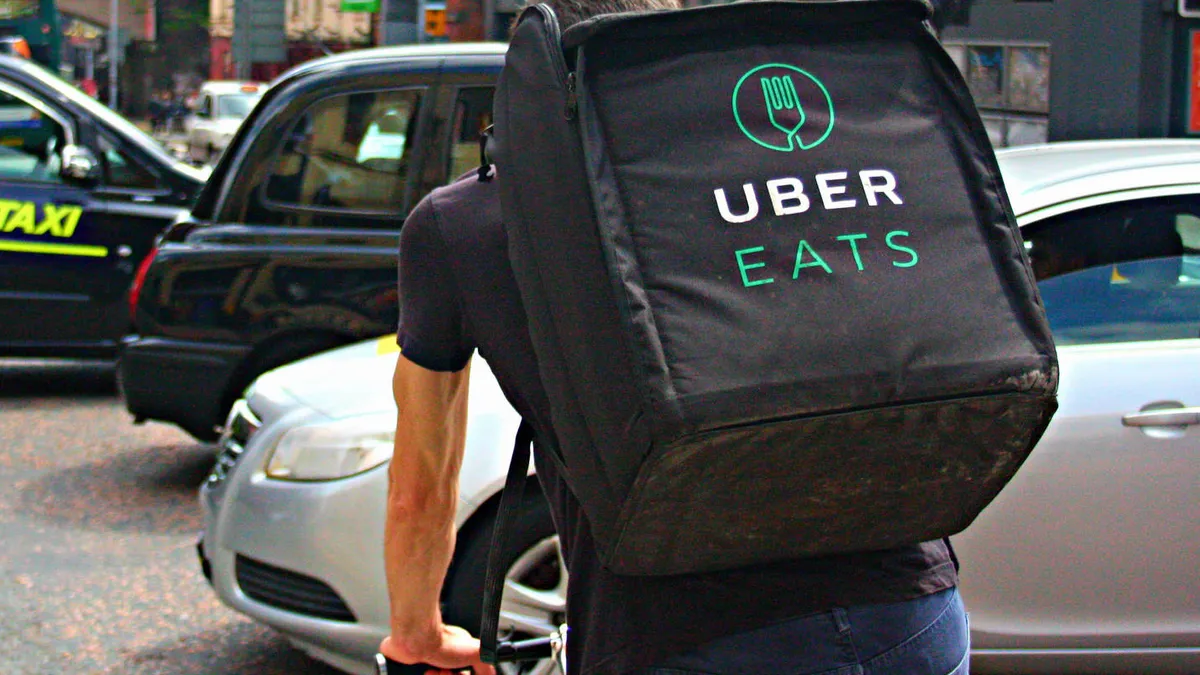Dive Brief:
- New York City officials expanded the timeline of its 20% cap on delivery commission fees, first put into place in May to help restaurants during the pandemic. The cap was set to expire on Sept. 18, according to Nation's Restaurant News, but has been extended until restaurants in the city are able to operate at 100% indoor capacity, plus an additional 90 days.
- Los Angeles also amended its 15% commission fee cap ordinance, originally set to expire Aug. 31, to extend to 90 days after restaurants are able to resume indoor dining capacity at 100%. The ordinance would also go into effect at any point if restaurants are mandated to reduce indoor capacity due to COVID-19.
- Other cities that have temporarily capped commission fees during the pandemic include Seattle, San Francisco, Washington, D.C., Las Vegas and Portland, Oregon.
Dive Insight:
Commission fee caps were put into place in a number of major cities to provide a temporary reprieve for restaurants as the pandemic gripped the nation and dining room closures became widespread. As the virus lingers in several states, and restaurants continue to operate at a fraction of full capacity, it makes sense for cities to extend these caps.
But the end game is tricky to predict, particularly as a number of experts expect a second wave of COVID-19 to hit in the fall. New York Gov. Andrew Cuomo hinted this month that restaurants may be forced to return to only takeout and delivery in the fall because of this. Los Angeles' ordinance makes it clear the commission fee cap will be brought back if restaurants are forced to retrench their dine-in operations again if a second wave hits.
This unpredictability no doubt pressures delivery companies to lay out their financial forecasts and as such, major delivery companies have pushed back. Earlier this month, for example, Grubhub launched a digital ad campaign in New York to protest the cap calling it a "food delivery tax." The company suggests that these caps increase how much consumers paying, limit restaurant orders and result in less work for drivers.
But restaurant operators, especially independents, have applauded the move. In Las Vegas, for example, one restaurant owner said, "This is going to save local businesses a huge amount of money," claiming fees to third-party delivery companies cost nearly $7,000 per month for one location.
Still, the pandemic has made it clear there is a symbiotic relationship between delivery companies and restaurants, with 81% of restaurant operators saying that third-party delivery has helped them prevent layoffs, according to a survey of 400 restaurants by Uber Eats and Technomic.
That said, delivery is no panacea. Even with New York's cap in place, for example, more than 80% of restaurant owners in the city were not able to pay full rent in July. A staggering number of those restaurants are expected to shutter even with companies like DoorDash reducing commissions for local restaurant partners starting in April.
Despite delivery companies' pushback, it's clear they are in a good position from increased usage during the pandemic. Uber Eats reported a 103% year-over-year revenue increase during Q2, while Grubhub executives called the pandemic a "permanent catalyst" for business as revenues jumped by 41%. This perhaps shows that commission fee caps and delivery company revenues can co-exist.
It's also worth noting that customer behavior toward delivery has changed significantly during this crisis. Delivery spend is up 173% year-over-year as of July 30, according to Cardlytics' latest State of Spend Report, which analyzes credit card data. Twenty-nine percent of consumers say they place an online order a few times a month, while 25% report they do so a few times a week, according to a Toast report.
So, even if commission fees go back to where they were pre-pandemic, restaurants might be able to pass those costs along to consumers, who may be more likely to pay for them. Some chains have already started doing just that.









